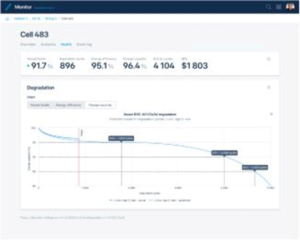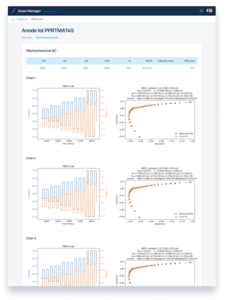One of the key factors that affects the performance, safety, and lifetime of a battery energy storage system (BESS) is the initial commissioning process and charging strategy. Inefficiencies introduced during this phase can have a significant impact on lifespan, degradation, and warranty. While BESS’s can have a high lifetime availability overall, this doesn’t mean they are running at peak efficiency, and failures often occur within the first two years1. As this article will illustrate, it’s essential to have access to a reliable and comprehensive battery data analytics solution to devise optimal charging strategies and ensure the best outcomes for the BESS.
Challenges of Battery Commissioning
As readers already know, battery commissioning is the process of testing, verifying, and validating the functionality and performance of a BESS before operation. Since failures have risen tenfold since 20162, it’s an even more critical step to ensure that the BESS meets the original design specifications and safety standards established by the regulatory organizations, manufacturers, and customer expectations. Battery commissioning can be a complex and time-consuming process, however, as it involves several significant challenges, including:
-
Data quality and availability: Battery commissioning requires collecting and analyzing data from various sources, such as cycler data, battery management system (BMS) data, and data from edge devices. However, these data sources may not be compatible, consistent, or complete, making it difficult to obtain a holistic and accurate view of the battery state and behavior. Many companies in the battery value chain are drowning in data. The battery data and analytics associated with manufacturing and operating LIB and non-LIB, for example, will increase 39% annually to 18 exabytes by 2030.
-
Data analysis and interpretation: Battery commissioning requires applying advanced data analysis and modeling techniques to evaluate the battery performance and health. These techniques may not be easy to implement, understand, or communicate, especially for non-experts. Moreover, the results may not be conclusive or actionable, as they may depend on various assumptions, parameters, and uncertainties.
-
Data integration and standardization: Battery commissioning requires integrating and standardizing the data from different sources and formats into a common framework and language. However, this can be a challenging and tedious task, as it may involve manual data entry, data cleaning, data transformation, and data validation, as we’ve written about in this newsletter in the past (see previous Issue 32, Issue 34 and Issue 35). Moreover, the data integration and standardization process may not be scalable, repeatable, or traceable, leading to data errors, inconsistencies, and inefficiencies. Customers we’ve spoken to said it can take a dedicated full-time person a week or more to complete this process, and can require difficult aggregation of large amounts of data from individual spreadsheets combined with other automated data sources.
Optimizing Battery Charging Strategies
During the commissioning phase, establishing efficient charging practices is essential for long-term performance and reliability. Areas of consideration include balancing, temperature, fast charging, and the use of analytics for developing informed strategies. This is true particularly for solar installations with battery storage, which account for 48% of failures2. Let’s explore what this entails.
Developing robust charging algorithms specific to the BESS chemistry and configuration is the main challenge. These algorithms consider factors like cell balancing, temperature control, and state of charge (SoC) management. This stage during commissioning involves calibrating SoC measurements accurately where BESS controllers need to enforce safe charge and discharge thresholds. Generally, the maximum DoD level for a BESS is 90%3. Maintaining an optimal SoC and DoD range ensures longevity, and overcharging or deep discharging can harm battery health over time and cause excessive wear and potential short circuits.
BESS components are particularly sensitive to temperature. During commissioning, it’s important to verify that cooling systems function correctly. Overheating accelerates degradation, while extreme cold reduces efficiency. Preheating the battery before commissioning in cold climates can also help to improve performance.
With fast charging considerations, commissioning often involves anticipating potential problem areas. While rapid charging expedites the process, it generates heat. Balancing speed with battery health is crucial, mainly by ensuring uniform charge distribution across cells. Cell balancing involves ensuring that all individual battery cells within the system or block have similar state of charge (SoC) levels. Proper cell balancing in this scenario enhances overall optimal performance, extends battery life, and prevents premature degradation.
Battery analytics applied during commissioning can provide valuable insights that would otherwise be left to guesswork. Historical data and real-time monitoring help predict behavior and identify anomalies. Fault Detection can provide early insight into cell imbalances, capacity deviations, or abnormal behavior and allow for corrective actions. Battery analytics solutions can also help establish optimal charging profiles using advanced analytics to recommend customized charging profiles based on BESS characteristics, ambient conditions, and usage patterns. These profiles balance performance, lifespan, and efficiency. For instance, many of our customers ask us to calculate capacity for individual charge and discharge segments using a Coulomb counting approach. This, in turn, is used as a basis for SoH measurements with the relation SoH = 100% Capacity Current (fully charged) / Capacity Rated (fully charged)).
In a nutshell, BESS commissioning involves fine-tuning charging strategies to achieve optimal performance, but data alone isn’t enough. Battery analytics brings disparate data sources together into a single normalized, parameterized view to empower engineers to make informed decisions, ensuring that these systems operate efficiently throughout their lifecycle, and most importantly that high value assets are protected from early or unexpected failure.


Battery analytics applied during commissioning can provide valuable insights that would otherwise be left to guesswork. Peaxy’s solution brings disparate data sources together into a single normalized, parameterized view to empower engineers to make informed decisions, ensuring that these systems operate efficiently throughout their lifecycle, and most importantly that high value assets are protected from early or unexpected failure. Example outputs illustrate automated feature extraction for battery metrology and cyclers, and degradation and SoH details.
How Battery Data and Analytics Can Help
At Peaxy, we’ve helped battery integrators and owners/operators to:
Collect data from disparate sources, such as cycler data, BMS data, and data from edge devices, and store it in a secure and scalable cloud environment. We can also connect to existing data sources and systems, such as SCADA, EMS, or DMS, and ingest data in real-time or batch mode. Even manufacturer data can be helpful at this stage, which is of course easier if a partnership exists, or the OEM is also acting as the integrator. For our battery and battery material manufacturer customers, we have captured, for example, 1,800 build and quality control parameters per battery, automating the collection of 95% of battery assembly data using our analytics solution. This data can prove invaluable farther into the battery lifecycle.
Aggregate, normalize, and parameterize data from different sources and formats into a single source of truth. We can also enrich the data with additional information, such as metadata, context, or labels, and apply quality checks and corrections to ensure data accuracy and completeness. After the data has been normalized and parameterized, cells and modules with inconsistent voltage, temperatures and/or current can be identified and corrected. A data set might be, for example, last year’s worth of OPC tags at 1 Hz from a power conversion system that is 200 tags wide (50 GB at double precision!). We often call these derived parameters “composite scores,” and they usually have values between 0-100. Their purpose is to characterize attributes such as overall performance, health, economic output vs. expected, or remaining useful life to name a few examples.
Analyze and visualize data using advanced data analysis and modeling techniques, such as machine learning, artificial intelligence, or physics-based models. This might include random forest, gradient boosting, finite element analysis (FEA), and electromagnetic field simulation, along with advanced data visualization techniques. Peaxy can also provide insights and recommendations on the battery performance, health, and degradation, and help to identify and diagnose issues, anomalies, or failures once the BESS is in operation. For instance, during the manufacturing phase but involving similar techniques used during commissioning, taking an SEM image of a Si/C colloid we are using to make a next gen lithium-ion anode, we might use “imageJ” to generate moments of the size distribution of that colloid. The average size, the variance of the size and so on would be the result of a feature extraction exercise.
Optimize charging strategies for the BESS to determine the optimal charging parameters, such as current, voltage, temperature, and duration, and adjust them dynamically according to the battery state and behavior, the grid conditions, and customer preferences. Our battery analytics solution can also help to avoid overcharging, undercharging, or improper charging of the batteries, which can have negative effects on the battery safety and performance, such as thermal runaway, capacity loss, or cycle life reduction. Moreover, we can help to extend the battery lifetime and prevent voiding manufacturer warranties, by ensuring that the charging strategies comply with the original manufacturer battery specifications and requirements.
Conclusion
As discussed above, battery data and analytics are essential for battery commissioning and optimal charging strategies. By having access to a unified view of battery data from relevant sources, battery integrators and owners/operators can improve the performance, safety, and lifetime of their BESS. Peaxy provides a data platform and a suite of analytics solutions that can help to collect, aggregate, normalize, parameterize, analyze, and optimize your battery data and charging strategies, to ensure the long-term value and performance of your valuable assets.
1 https://www.nacleanenergy.
2 Batteries Not Excluded: Getting the insurance market on board with BESS Q1 2024
3 https://evreporter.com/

